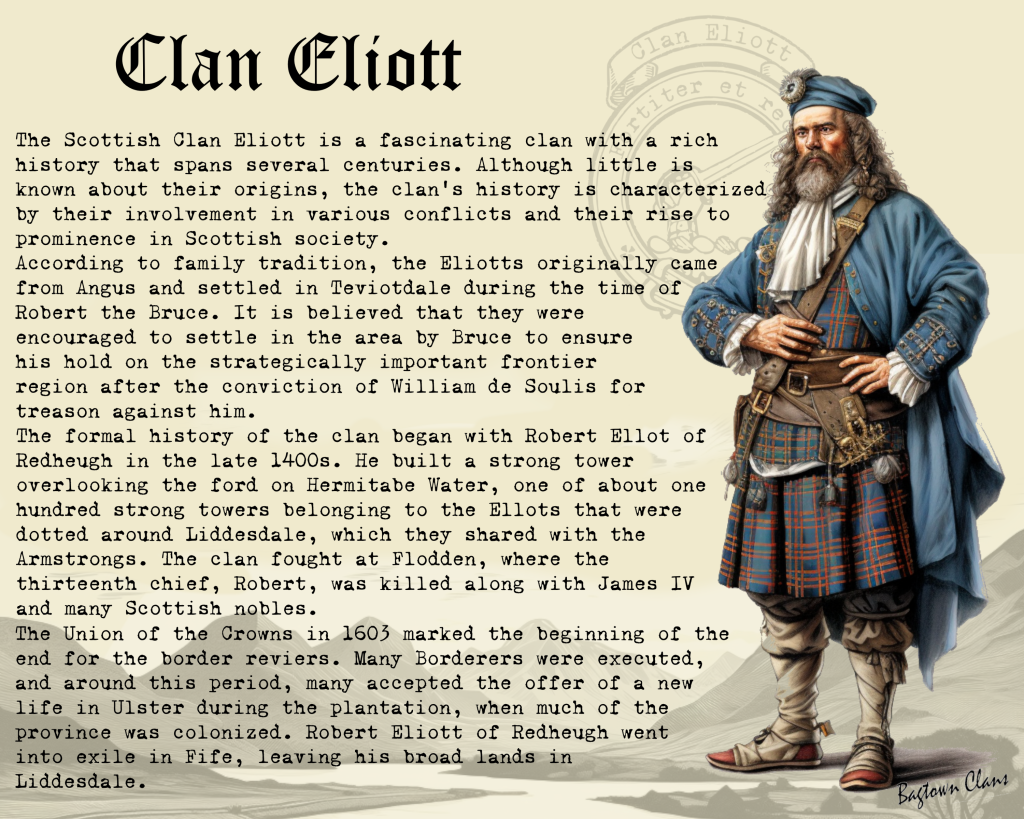Eliott Clan
|
|
CREST: A hand couped at the wrist in amour holding a cutlass in bend Proper MOTTO: Fortier et recte TRANSLATION: Boldly and rightly TARTAN: Blue ground, Brown checks, Red lines. VARIATIONS: Elliot, Elliott |
 The Scottish Clan Eliott is a fascinating clan with a rich history that spans several centuries. Although little is known about their origins, the clan’s history is characterized by their involvement in various conflicts and their rise to prominence in Scottish society. The Scottish Clan Eliott is a fascinating clan with a rich history that spans several centuries. Although little is known about their origins, the clan’s history is characterized by their involvement in various conflicts and their rise to prominence in Scottish society.
According to family tradition, the Eliotts originally came from Angus and settled in Teviotdale during the time of Robert the Bruce. It is believed that they were encouraged to settle in the area by Bruce to ensure his hold on the strategically important frontier region after the conviction of William de Soulis for treason against him. The formal history of the clan began with Robert Ellot of Redheugh in the late 1400s. He built a strong tower overlooking the ford on Hermitabe Water, one of about one hundred strong towers belonging to the Ellots that were dotted around Liddesdale, which they shared with the Armstrongs. The clan fought at Flodden, where the thirteenth chief, Robert, was killed along with James IV and many Scottish nobles. The Eliotts had a deadly feud with their neighbors, the Scots, in 1565 over the minor crime of cattle rustling. Four Ellots were executed by Scott of Buccleuch, and three hundred Ellots rode to avenge their kinsmen. The losses on both sides were heavy, but the Scots eventually came to terms with the Ellots. In 1569, a royal force of nearly four thousand men devastated the lands of the Ellots and their neighbors in reprisal for a skirmish around Hermitage Castle with James Hepburn, the great Earl of Bothwell and future husband of Mary, Queen of Scots. The Union of the Crowns in 1603 marked the beginning of the end for the border reviers. Many Borderers were executed, and around this period, many accepted the offer of a new life in Ulster during the plantation, when much of the province was colonized. Robert Eliott of Redheugh went into exile in Fife, leaving his broad lands in Liddesdale. It was around the 1650s that the ‘I’ was introduced into the name of Ellot. Despite these turbulent times, the Eliotts continued to rise in Scottish society. Sir Gilbert Eliott of Stobs became chief in 1673 and was created a Baronet of Nova Scotia by Charles II in December 1666. The Eliott clan produced some persons of distinction, including Augustus, a distinguished soldier who was rewarded for his spirited defense of Gilbralter in 1782 with a peerage. Another branch of the chiefly family acquired the lands of Minto in 1703 and produced Sir Gilbert Eliott of Minto, a diplomat who served first in Corsica, then in Vienna, finally becoming Governor General of Bengal. He returned from India in 1813 to be created Earl of Minto and viscount Melgund. The Eliott clan has faced many challenges throughout their history, but they have always remained a proud and resilient people. Today, the clan is led by the daughter of Sir Arthur Eliott, eleventh Baronet and twenty-eighth chief. She assumed her father’s seat on the Council of Chiefs, but the baronetcy passed to a male heir. The history of the Scottish Clan Eliott is a fascinating one that has been marked by conflict, turmoil, and perseverance. The clan’s rise to prominence in Scottish society is a testament to their strength and resilience, and their legacy continues to inspire and captivate people to this day. |
|
Citations:
|
|

Purchase @ Redbubble
Purchase @ Amazon.com
Purchase @ Amazon.co.uk

